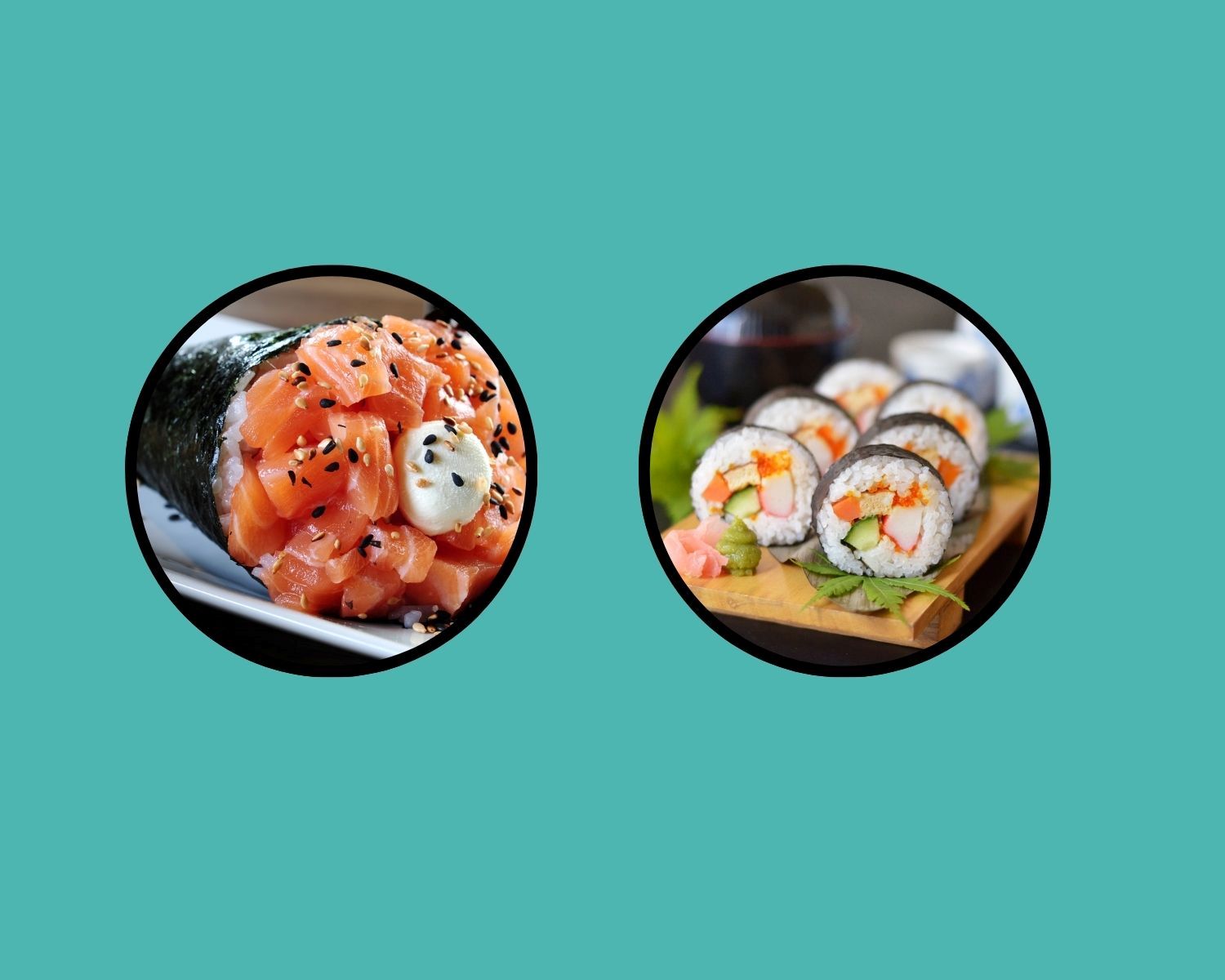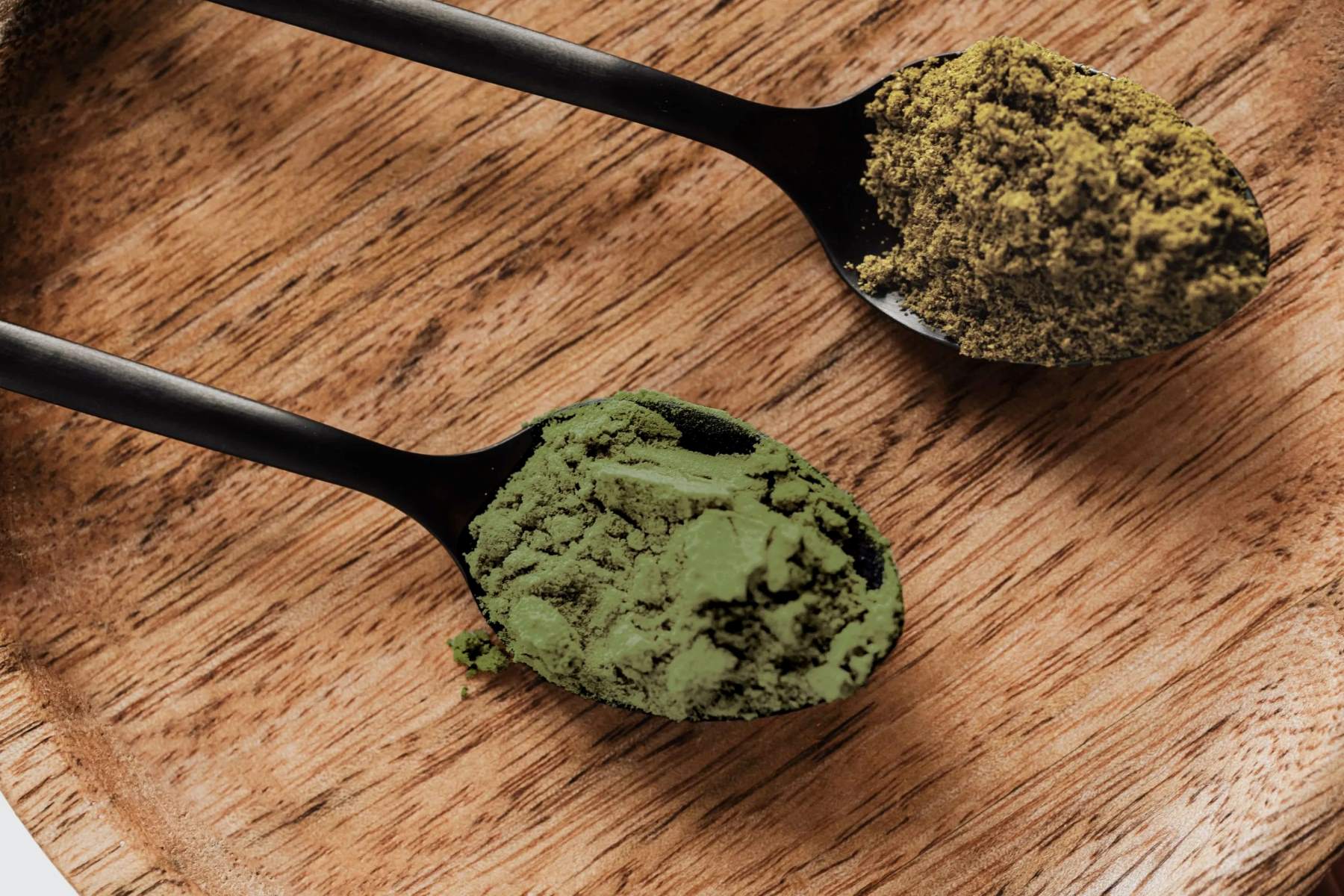Home>Food and Cooking>The Ultimate Guide To Temaki Vs Maki: Unveiling The Sushi Showdown


Food and Cooking
The Ultimate Guide To Temaki Vs Maki: Unveiling The Sushi Showdown
Published: February 1, 2024
Discover the key differences between temaki and maki sushi in this ultimate guide to the sushi showdown. Explore the world of food and cooking with expert insights.
(Many of the links in this article redirect to a specific reviewed product. Your purchase of these products through affiliate links helps to generate commission for Regretless.com, at no extra cost. Learn more)
Table of Contents
Introduction
Sushi, a beloved culinary delight that has captured the hearts and taste buds of people worldwide. Within the realm of sushi, two prominent stars shine brightly: Temaki and Maki. These two traditional Japanese delicacies have made their mark in the global gastronomic scene, each offering a unique experience that tantalizes the senses. As we embark on this culinary journey, we will unravel the intricacies of Temaki and Maki, delving into their origins, characteristics, and the art of their creation.
Get ready to embark on a delectable adventure as we uncover the distinctive features of Temaki and Maki, gaining a deeper understanding of what sets these sushi varieties apart. Whether you're a sushi aficionado or a curious food enthusiast, this ultimate guide will equip you with the knowledge to appreciate and savor these exquisite creations like never before. So, fasten your seatbelts and prepare to indulge in the tantalizing world of Temaki vs Maki, where every bite tells a story of tradition, craftsmanship, and culinary finesse.
Understanding the Basics of Temaki
Temaki, which translates to "hand roll" in Japanese, is a popular style of sushi known for its distinctive cone shape. This delectable creation is made by wrapping a variety of fresh ingredients in nori (seaweed) and seasoned rice, resulting in a portable and visually appealing treat. Unlike its counterparts, such as nigiri and sashimi, temaki offers a unique dining experience, allowing enthusiasts to savor a harmonious blend of flavors and textures in each bite.
The key components of a temaki roll include nori, which imparts a subtle oceanic flavor and a satisfying crunch, and sumptuously seasoned sushi rice, which serves as the foundation for an array of fillings. From succulent slices of sashimi to crisp, vibrant vegetables, the filling options are as diverse as they are delightful. This versatility enables temaki to cater to a wide range of palates, making it an ideal choice for both seafood lovers and vegetarians alike.
One of the defining characteristics of temaki is its interactive nature. Traditionally served unassembled, diners are encouraged to craft their own temaki rolls at the table, adding a personalized touch to their dining experience. This hands-on approach not only fosters a sense of culinary creativity but also promotes a communal atmosphere, as friends and family come together to share in the joy of assembling and savoring these delectable creations.
Temaki's informal and convivial nature makes it an excellent choice for social gatherings, as it encourages lively conversation and a shared appreciation for the art of sushi. Furthermore, its portable design makes it a convenient option for on-the-go dining, allowing individuals to relish its flavors and textures wherever they may be.
In essence, temaki embodies the essence of Japanese cuisine – a harmonious fusion of quality ingredients, meticulous preparation, and an unwavering commitment to delivering a memorable dining experience. As we continue our exploration of the sushi universe, let's venture into the realm of maki, where a different culinary adventure awaits.
Exploring the World of Maki
Maki, an iconic member of the sushi family, offers a delightful culinary journey characterized by its elegant and uniform appearance. Unlike the hand-rolled temaki, maki comprises a cylindrical shape, achieved by wrapping nori and rice around a variety of tantalizing fillings. This meticulous process results in perfectly proportioned slices that showcase a symphony of flavors and colors, making it a feast for both the eyes and the palate.
The world of maki is a diverse and vibrant one, with a myriad of variations to suit every discerning palate. From the classic Hosomaki, featuring a single filling wrapped in nori and rice, to the extravagant Futomaki, boasting a delightful medley of ingredients, maki presents an enticing array of options to cater to different tastes and preferences. Furthermore, the creative potential of maki knows no bounds, as innovative fusion rolls continue to captivate sushi enthusiasts with their inventive combinations and artistic presentations.
At the heart of maki lies a harmonious blend of textures and flavors, carefully curated to deliver a sensorial experience that transcends mere sustenance. Whether it's the buttery richness of fresh sashimi, the crispness of cucumber and avocado, or the subtle heat of spicy tuna, each maki roll offers a symphony of tastes that harmonize to create a truly unforgettable dining experience.
Beyond its culinary appeal, maki also embodies a profound cultural significance, reflecting the artistry and precision that are hallmarks of Japanese cuisine. The meticulous assembly of each roll, the seamless fusion of complementary ingredients, and the artful presentation on the plate all speak to the dedication and craftsmanship that define the world of maki.
As we delve deeper into the realm of maki, we uncover a rich tapestry of tradition, innovation, and culinary mastery. Each slice of maki tells a story of creativity and expertise, inviting us to embark on a gastronomic adventure that celebrates the art of sushi in all its glory.
Temaki vs Maki: A Detailed Comparison
When exploring the world of sushi, understanding the nuances that set Temaki and Maki apart is essential to fully appreciate their distinct charms. While both varieties share the common elements of nori and seasoned rice, their presentation, dining experience, and flavor profiles diverge, offering unique culinary encounters for sushi enthusiasts.
Temaki:
- Presentation: Temaki, known as the "hand roll," boasts a cone-shaped structure that showcases its vibrant fillings, with the nori wrapping gracefully unfurling to reveal a tantalizing assortment of ingredients.
- Dining Experience: The interactive nature of temaki allows diners to engage in the hands-on process of assembling their rolls, fostering a communal dining experience and a sense of culinary creativity.
- Flavor Profile: With each bite, the harmonious blend of nori, seasoned rice, and an array of fillings delivers a medley of textures and flavors, offering a delightful interplay of freshness and crunch.
Maki:
- Presentation: Maki, characterized by its cylindrical shape, offers uniform slices that showcase a visually appealing arrangement of ingredients, reflecting the precision and artistry of its preparation.
- Dining Experience: Maki's uniform slices lend themselves to a refined dining experience, where each piece is meticulously crafted to deliver a balanced combination of flavors, textures, and visual aesthetics.
- Flavor Profile: The symphony of flavors in maki rolls unfolds with each slice, presenting a harmonious blend of ingredients that tantalize the palate with their meticulous arrangement and complementary nuances.
In essence, while Temaki embraces an informal and interactive dining style, Maki embodies a refined and visually captivating experience. The contrasting presentations and dining dynamics of these sushi varieties cater to diverse preferences, making them suitable for both casual gatherings and formal dining occasions.
As we unravel the intricacies of Temaki and Maki, it becomes evident that their differences extend beyond their physical appearance, enriching the sushi landscape with a delightful array of dining experiences. Whether savoring the convivial charm of Temaki or indulging in the artful precision of Maki, each variety offers a distinct and memorable encounter that celebrates the richness of Japanese culinary tradition.
The Art of Making Temaki and Maki
Crafting Temaki and Maki is a culinary art form that demands precision, creativity, and a deep appreciation for the harmonious interplay of flavors and textures. The process begins with the meticulous preparation of the foundational elements – nori and seasoned sushi rice – laying the groundwork for a symphony of ingredients to come together in perfect harmony.
Temaki:
The creation of Temaki is a testament to the art of balance and composition. The first step involves delicately toasting the nori sheets to enhance their umami-rich flavors and ensure a satisfying crunch. The seasoned sushi rice, meticulously crafted with a precise blend of rice vinegar, sugar, and salt, serves as the canvas upon which an array of fillings will shine.
Assembling a Temaki roll requires finesse and a keen eye for proportion. With the nori sheet cradled in the palm, a generous portion of seasoned rice is carefully spread, creating a foundation for the vibrant fillings. From succulent sashimi to crisp vegetables and creamy avocado, the artistry lies in the arrangement of ingredients, ensuring a harmonious blend of flavors and textures in every bite.
The final flourish comes with the expert rolling technique, as the cone-shaped Temaki takes form, encapsulating the medley of fillings within its embrace. The seamless union of nori, rice, and fillings is a testament to the skill and precision of the sushi chef, culminating in a visually stunning creation that tantalizes the senses.
Maki:
Crafting Maki is a meticulous process that celebrates the art of precision and presentation. The nori sheet, carefully selected for its texture and flavor, serves as the foundation for the symmetrical arrangement of ingredients. The seasoned sushi rice, with its subtle sweetness and delicate vinegary tang, acts as the cohesive element that binds the fillings together.
Assembling a Maki roll demands attention to detail and a commitment to aesthetic excellence. The ingredients, whether vibrant sashimi, crisp vegetables, or creamy avocado, are meticulously arranged to create a visually captivating tapestry of colors and textures. The seamless rolling technique, facilitated by a bamboo mat, ensures that each slice of Maki exudes elegance and uniformity.
The artistry of Maki extends beyond its visual appeal, encompassing the precise slicing technique that yields perfectly portioned rolls. Each slice showcases the chef's expertise and dedication to presenting a symphony of flavors in a visually stunning format, inviting diners to partake in a sensorial journey that celebrates the art of sushi.
In essence, the art of making Temaki and Maki transcends mere culinary craftsmanship, embodying a profound reverence for tradition, creativity, and the pursuit of gastronomic excellence. From the meticulous assembly to the visual allure, every step in the creation of Temaki and Maki reflects a dedication to preserving the timeless art of sushi, ensuring that each roll is a masterpiece to be savored and celebrated.
Choosing Between Temaki and Maki
When faced with the delightful dilemma of choosing between Temaki and Maki, one is presented with a captivating culinary conundrum. Each variety offers a distinct dining experience, characterized by its presentation, flavor profile, and the dynamics of its consumption. Understanding the nuances of Temaki and Maki is essential in making an informed decision, allowing one to tailor their sushi indulgence to suit their preferences and occasion.
Temaki:
The allure of Temaki lies in its interactive and convivial nature. This hand-rolled delicacy invites diners to engage in the hands-on process of assembling their rolls, fostering a communal dining experience and a sense of culinary creativity. The cone-shaped presentation of Temaki showcases its vibrant fillings, with the nori wrapping gracefully unfurling to reveal a tantalizing assortment of ingredients. The flavor profile of Temaki is characterized by a harmonious blend of nori, seasoned rice, and an array of fillings, offering a delightful interplay of freshness and crunch.
Maki:
In contrast, Maki embodies a refined and visually captivating dining experience. The cylindrical shape of Maki yields uniform slices that showcase a visually appealing arrangement of ingredients, reflecting the precision and artistry of its preparation. The symphony of flavors in Maki unfolds with each slice, presenting a harmonious blend of ingredients that tantalize the palate with their meticulous arrangement and complementary nuances.
When making the choice between Temaki and Maki, several factors come into play. For a casual gathering or a lively social event, Temaki's interactive and informal nature lends itself to a convivial dining experience, where friends and family can come together to craft their own rolls, fostering a sense of camaraderie and shared culinary enjoyment. On the other hand, Maki's refined presentation and meticulous flavor composition make it an ideal choice for formal dining occasions or when seeking a visually captivating sushi experience.
Ultimately, the choice between Temaki and Maki hinges on the desired dining atmosphere, the preference for interactive or refined dining experiences, and the occasion at hand. Whether opting for the communal charm of Temaki or the artful precision of Maki, each variety promises a delightful and memorable encounter that celebrates the richness of Japanese culinary tradition.
Conclusion
In the realm of sushi, Temaki and Maki stand as shining examples of culinary artistry, each offering a unique and captivating dining experience. As we journeyed through the nuances of these traditional Japanese delicacies, we uncovered the distinct characteristics that set them apart, from their presentation and flavor profiles to the dynamics of their consumption.
Temaki, with its cone-shaped allure and interactive dining style, invites diners to partake in a hands-on culinary adventure. The vibrant fillings, nestled within the nori and seasoned rice, offer a harmonious blend of textures and flavors, creating a delightful interplay that tantalizes the senses. Whether enjoyed in a casual setting or as a portable treat on the go, Temaki embodies the convivial charm of communal dining, fostering a sense of creativity and camaraderie among diners.
On the other hand, Maki captivates with its refined presentation and meticulous flavor composition. The cylindrical rolls, meticulously crafted to showcase a symphony of ingredients, offer a visually captivating and sensorially satisfying dining experience. From classic variations to innovative fusion creations, Maki invites diners to embark on a gastronomic journey that celebrates the art of sushi in all its glory.
As we consider the choice between Temaki and Maki, it becomes evident that both varieties hold a distinct place in the world of sushi, catering to diverse preferences and dining occasions. Whether seeking an interactive and convivial dining experience or an artfully presented culinary indulgence, the decision between Temaki and Maki is guided by the desired atmosphere and the occasion at hand.
In essence, the world of Temaki and Maki embodies the rich tapestry of Japanese culinary tradition, reflecting a profound reverence for quality ingredients, meticulous preparation, and an unwavering commitment to delivering a memorable dining experience. Whether savoring the informal charm of Temaki or indulging in the refined precision of Maki, each variety promises a delightful encounter that celebrates the artistry and diversity of sushi.
As we conclude our exploration of Temaki vs Maki, let us celebrate the vibrant tapestry of flavors, textures, and cultural significance that these sushi varieties bring to the table. Whether as a communal delight or a refined indulgence, Temaki and Maki invite us to partake in a timeless culinary tradition that continues to captivate and inspire food enthusiasts around the world.














